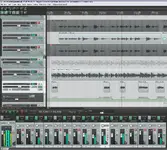M
Matt Beddall
New member
My band have decided to record some of our songs using cubase 5, it's our first attempt at recording ourselves as all our other stuff was recorded in a studio.
We're 2 songs in and learning as we go but this problem keeps cropping up and we don't know what we're doing wrong.
We are currently trying to master our 2nd song and we're really happy with the mix and how everything sounds apart from the overall volume, it's a bit quiet when compared to stuff that has been on general release.
As we were exporting the separate tracks into 1 stereo track we could only set the master fader to -4 db, any higher caused it to clip, I think I read somewhere that we need to export at 0db but I may have taken that out of context.
We are mastering using ozone5 and I recently read that it's possible to increase the volume using the maximiser which I think works like a limiter?
I'd be grateful of any advice at all, if someone can point me in the right direction I'm happy to research any info, but at the moment our lack of knowledge has stalled our recordings as we don't want to make the same mistake on the next song if it's something we need to be aware of from the start
Cheers for reading
We're 2 songs in and learning as we go but this problem keeps cropping up and we don't know what we're doing wrong.
We are currently trying to master our 2nd song and we're really happy with the mix and how everything sounds apart from the overall volume, it's a bit quiet when compared to stuff that has been on general release.
As we were exporting the separate tracks into 1 stereo track we could only set the master fader to -4 db, any higher caused it to clip, I think I read somewhere that we need to export at 0db but I may have taken that out of context.
We are mastering using ozone5 and I recently read that it's possible to increase the volume using the maximiser which I think works like a limiter?
I'd be grateful of any advice at all, if someone can point me in the right direction I'm happy to research any info, but at the moment our lack of knowledge has stalled our recordings as we don't want to make the same mistake on the next song if it's something we need to be aware of from the start
Cheers for reading



